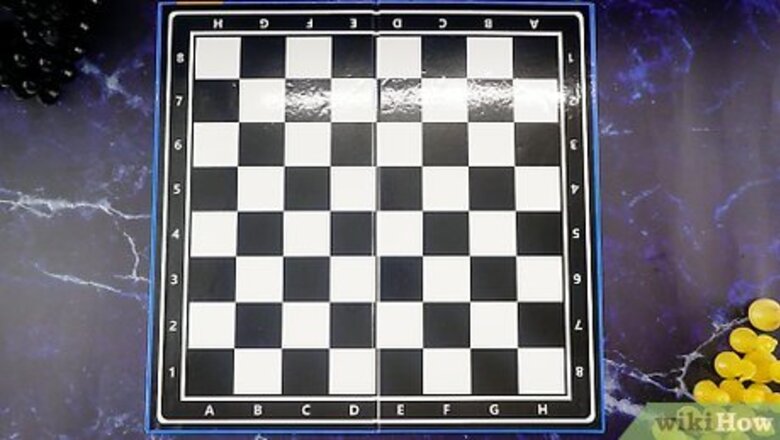
views
Setting Up a Chessboard
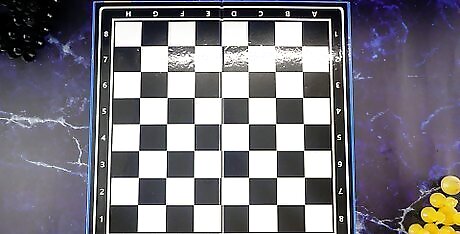
Set the board so that the bottom-right square is a light square. Both players will have a light square in the right corner on the edge of the board closest to them. The setup for each player looks identical from their perspective. You set up your pieces on the two horizontal rows ("ranks") closest to you. The major pieces go on the first rank. The pawns go on the second rank. Unlike in checkers, chess uses every single square on the board. When setting up your chessboard, a tip to keep in mind is that White is always on rank 1 and 2 and that Black is always on ranks 7 and 8.
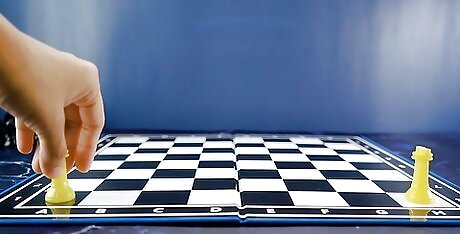
Place your rooks in each corner. Start with your rooks (sometimes called castles), which are tall pieces that move in straight lines horizontally (along "ranks") and vertically (along "files"). Place a rook on each of your two corners. On a novelty board, such as Civil War sets or movie-themed pieces, it may be impossible to tell what a piece is without knowing the icons (or rule-book symbols) which may be marked on the bottom of the pieces. The symbol for a rook is ♜.
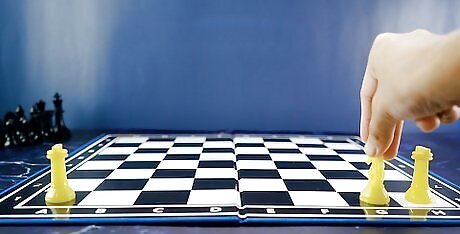
Place the knights next to the rooks. The knights, which look like horses, go just to the right and left of the rooks. Knights move three squares in an "L" shape, first two spaces in one direction, then one space in another, or first one space in one direction, then two in another. Knights can hop over pieces to make their moves, being the only pieces allowed to do so. The symbol for a knight is♞.

Place the bishops to the inside of the knights. The tall, round-topped bishops start next to the knights. Bishops move only along diagonal lines. The symbol for a bishop is♝. The left bishop will start on a dark square (and always remain on dark). The right bishop starts on a light square (and always remains on light).

Place the queen on the remaining, matching-color square. If you are the white side, your queen goes on the remaining white square in the middle of the first rank. If you are playing black, your queen goes on the remaining black square. The queen is one of the tallest pieces in the game and has a spiked crown. She can move horizontally, vertically, or diagonally any number of spaces, making her the most powerful piece on the board. The symbol for the queen is ♛.

Place the king on the last open square of the first rank. The king is usually the tallest piece on the board and appears to wear a rounded crown often topped with a cross. The king can move in any direction but only one space at a time. You use the rest of your pieces to protect your king. If you lose your king, you lose the game. The symbol for the king is ♚.
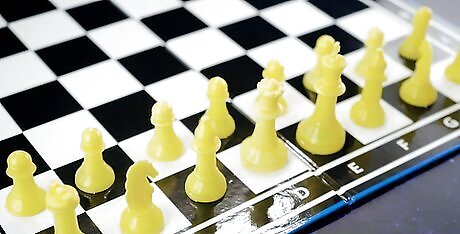
Place the pawns along the second rank. After you've put your major pieces on the first rank, line up the lowly pawns like a protective wall on the second rank. Pawns move forward one space at a time, but they can make a variety of special moves, too. The symbol for pawns is ♟. Once both players place their pieces like shown above, they're ready to play.

Review your pieces. Your first two rows should look like this (black side): ♟♟♟♟♟♟♟♟♜♞♝♚♛♝♞♜ EXPERT TIP Sahaj Grover Sahaj Grover Chess Grandmaster Sahaj Grover is a Chess Grandmaster, World Champion, and coach, who attained his Grandmaster title at the age of 16. He has been a World Junior Bronze Medalist, World U10 Champion, South African Open 2017 & 2018 Champion, and the Winner of the Arnold Classic 2018 & 2019. Sahaj is known for dynamic attacking skills and being an excellent endgame player. Sahaj Grover Sahaj Grover Chess Grandmaster Try this variation: There's a variant of chess called Chess960. In this format, the pieces are set up randomly on the first rank, and the pawns remain the same. This was developed so players aren't able to prepare beforehand, so they have to be more creative when they play.
Understanding Chess Rules
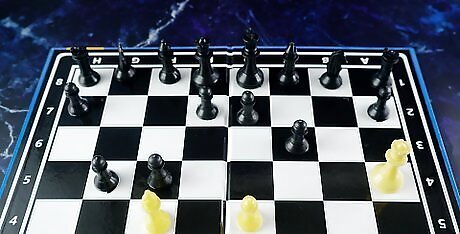
Win the game by "checkmating" your opponent's king. This occurs when the king cannot escape check no matter what. By contrast, your opponent's king is merely "in check" if you could capture him on your next move but the opponent has a means of escaping. A player must immediately move their king out of check if it's possible to do so. You never actually capture a king. Once it's apparent that a king cannot avoid being captured on the next move, checkmate is immediately declared, and the game is over. Some players like to say "check" when they make a move that puts the opponent's king in immediate danger. You may not place your own king in check. Such a move is considered "illegal" and must be immediately rescinded.
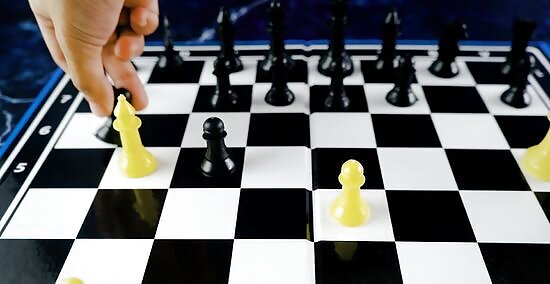
Capture the opponent's pieces to remove them from the game. If one of your pieces makes a move that ends on a square already occupied by an opponent's piece, you "capture" that piece and remove it from the game. Your piece then takes the captured piece's place on that square. You cannot capture your own pieces or occupy any square with more than one piece. In other words, you cannot move a piece through or to a square already occupied by one of your pieces—with the exception of your knights. They may move over any other piece (but may not end a move on a square already occupied by one of your pieces). With the exception of the pawn, you can capture pieces only with a "normal" move. For example, rooks can capture only with vertical or horizontal moves. You cannot move over a piece to capture another one. If your piece "hits" another piece during its movement, it stops, captures the piece, and stays on that square. The knight is the only exception to this, as it takes a piece only when it ends a move by landing on that piece's square.

Begin with White. White always makes the first move, and the players alternate after that. For players of equal ability, there is a slight advantage to going first. Each turn consists of one player moving one piece. A player must move a piece every turn. They cannot skip a turn simply because they don't know where to move. If a player has no legal moves and is not in check, the game is a stalemate (see below). The only exception to the "move one piece" rule is called "castling," which allows a player to move two pieces at once in a specific pattern to protect the king. See below for more on castling.
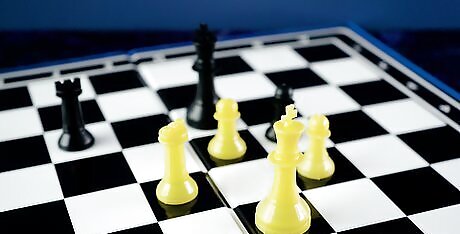
Watch out for stalemate. A game can end in a tie "draw". Stalemate occurs when neither king is in check and the next player to move has no legal move available. If you are in an advantageous position, you would want to avoid stalemate. (The opposite is true if you are in a weak position and would love to force a draw.) Stalemate typically may occur when there are only a few pieces left such as pawns blocked by other pawns, and kings that can't move without putting themselves in check. Remember that you can never put yourself in check. Thus, if it's your turn to move and your only available move would put your king in check, the game is over, and a stalemate is declared. In some tournaments this means you lose, although most players call this a draw. Stalemate does not occur if either king is currently in check.
Moving the Pieces
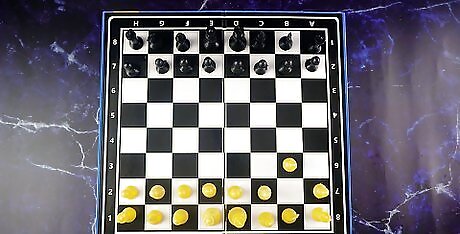
Move pawns one space forward. That is usually all they can do, so they're not very useful. However, in certain circumstances, they become quite effective: If your pawn gets all the way to the first rank (for White) or eighth rank (for Black), you can '"promote"' the pawn to any piece other than the king or pawn. That means that a pawn that has advanced very far along its file becomes quite powerful. Players typically promote to a queen but may promote to another piece to avoid stalemate or use the knight's move (promoting to a piece other than the queen is called "underpromotion"). In its very first move, a pawn may (but does not have to) move two spaces forward instead of one. A pawn can capture a piece that is diagonally one square in front of it. It cannot capture an otherwise adjacent piece. En passant, or "capture in passing", can occur when the opponent moves their pawn two spaces ahead to avoid moving into your pawn's capture position (forward-diagonally adjacent). If this happens, only on your very next turn you can move your pawn diagonally into the space they skipped and take that pawn anyway.
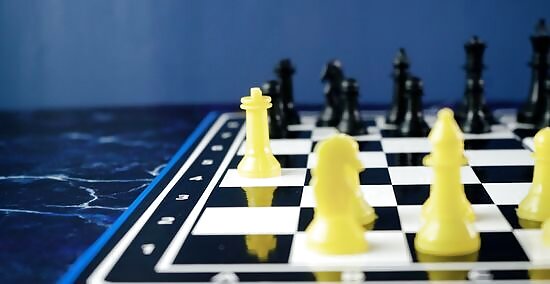
Move rooks an unlimited number of spaces vertically or horizontally. Rooks move in straight lines forward, backward, or sideways. They can cross as many vacant squares as they want but must stop if they come to another piece (or, of course, the edge of the board). If an enemy piece is in the way, the rook must stop before the piece or capture it. If it's your own piece, it must stop before it comes to that square. (You cannot capture your own pieces.)
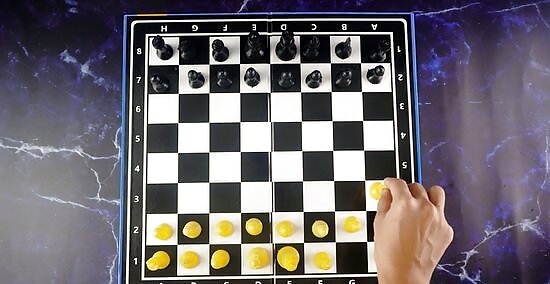
Move knights in an "L"-shape. Knights have the most distinctive movement in the game: they "hop" three times, first two spaces in one direction and then one space in a perpendicular direction, or first one space in any direction and then two spaces perpendicularly. Knights are the only pieces allowed to hop over other pieces of either color. They capture a piece only by finishing their move on a square occupied by an enemy piece. (They cannot finish on a square already occupied by a piece of their own color.)

Move bishops any number of spaces diagonally. Bishops can move in four directions: diagonally right or left (either forward or backward). This means a bishop always stays on the same color squares. For example, if it begins on a light square, there is no way for a bishop ever to get onto a dark square. Bishops cannot hop over pieces. If there is a piece in the way, the bishop must either stop or (if it's an opponent's piece) capture it.

Move the queen in a straight line in any direction and any number of spaces. She can move forward, backward, sideways, and diagonally as many vacant spaces as she wants. This makes her your most powerful piece. A queen cannot move in the knight's L-shaped pattern. A queen cannot move over pieces. She must complete her move either by stopping before coming to another piece or by capturing that piece.
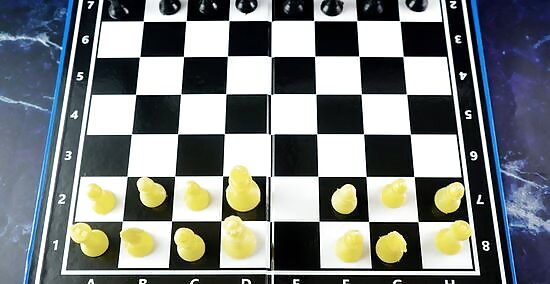
Move the king in any direction one space at a time. Kings can move one space forward, backward, sideways, or diagonally. The only exception is called castling, whereby a king and one of the rooks switch positions to help defend the king. In order to castle: Neither the king nor the rook can have moved at any point in the game thus far. There can be no pieces in between the rook and the king. The king cannot be in check at the time of castling, nor can the king in castling move through or to a square in which he would be in check. In one turn, move the king two spaces towards the rook, then slide the rook into the square the king skipped over. They will now be on opposite sides and right next to each other.



















Comments
0 comment